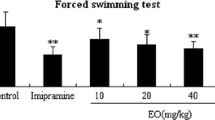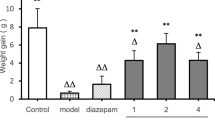Abstract
Lantana camara Linn. (Verbenaceae) is used traditionally for its numerous medicinal properties such as antimalarial, antibacterial, anticancer and anti-inflammatory. In the present study, we investigated the chemical composition of essential oil from the leaves of L. camara (LCEO) occurring in the Republic of Benin (West Africa) in comparison with LCEOs from other regions; evaluated its sedative effects in mice via inhalation administration; and identified the compounds responsible for activity. LCEO was extracted by hydrodistillation and chemical analyses of the oil were performed by GC and GC/MS. The oil was dominated by monoterpene hydrocarbons (60.58%) and oxygenated monoterpenes (33.39%), among which sabinene (38.81%) and 1,8-cineole (28.90%) were the most abundant. LCEO administered via inhalation to mice significantly decreased locomotor activity in a dose-dependent manner, mainly at the doses of 0.0004 and 0.04 mg per 400 μL of triethyl citrate (TEC). The oil was fractionated to give two fractions, which were further investigated, and revealed that both sabinene and 1,8-cineole were the principal active compounds. The results of the present study indicated that via inhalation administration, LCEO and its main constituents could be considered as promising candidates for the management of dementia, insomnia, attention deficit hyperactivity disorder and other central nervous system-associated diseases.
Graphic abstract





Similar content being viewed by others
References
Sharma O, Dawra R, Pattabhi V (1991) Molecular structure, polymorphism and toxicity of lantadene A, the pentacyclic triterpenoid from the hepatotoxic plant, Lantana camara. J Biochem Toxicol 6:57–63
Khan M, Mahmood A, Alkhathlan HZ (2016) Characterization of leaves and flowers volatile constituents of Lantana camara growing in central region of Saudi Arabia. Arab J Chem 9:764–774. https://doi.org/10.1016/j.arabjc.2015.11.005
Sonibare OO, Effiong I (2008) Antibacterial activity and cytotoxicity of essential oil of Lantana camara leaves from Nigeria. Afr J Biotechnol 7:2618–2620
Weenen H, Nkunya H, Bray H et al (1990) Antimalarial activity of Tanzanian medicinal plants. Planta Med 56:368–370
Deena MJ, Thoppil JE (2000) Antimicrobial activity of the essential oil of Lantana camara. Fitoterapia 71:453–455
Alitonou G, Avlessi F, Bokossa I et al (2004) Chemical composition and biological activities of essential oil from Lantana camara Linn. C R Chimie 7:1101–1105
Fujiwara Y, Ito M (2015) Synergistic effect of fragrant herbs in Japanese scent sachets. Planta Med 81:193–199. https://doi.org/10.1055/s-0034-1396138
Ito K, Ito M (2011) Sedative effects of vapor inhalation of the essential oil of Microtoena patchoulii and its related compounds. J Nat Med 65:336–343. https://doi.org/10.1007/s11418-010-0502-x
Sinha D, Efron D (2005) Complementary and alternative medicine use in children with attention deficit hyperactivity disorder. J Paediatr Child Health 41:23–26. https://doi.org/10.1111/j.1440-1754.2005.00530.x
Takemoto H, Ito M, Shiraki T et al (2008) Sedative effects of vapor inhalation of agarwood oil and spikenard extract and identification of their active components. J Nat Med 62:41–46
Tankam JM, Ito M (2013) Inhalation of the essential oil of Piper guineense from Cameroon shows sedative and anxiolytic-like effects in mice. Biol Pharm Bull 36:1608–1614. https://doi.org/10.1248/bpb.b13-00491
Ogawa K, Miyoshi T, Kitayama T, Ito M (2014) Locomotor-reducing effects and structural characteristics of inhaled zerumbone and tetrahydrozerumbone derivatives. Biol Pharm Bull 37:1559–1563
Tankam JM, Ito M (2014) Sedative, anxiolytic and antidepressant-like effects of inhalation of the essential oil of Ocimum gratissimum L. from Cameroon in mice. J Pharmacogn Phytochem 2:1–9
Ogawa K, Yabe H, Kitayama T, Ito M (2016) Locomotor-reducing activity of sesquiterpenes related to Zingiber zerumbet essential oil and hexahydrozerumbone derivatives. Biol Pharm Bull 39:1077–1080. https://doi.org/10.1248/bpb.b16-00141
Karimi AG, Ito M (2012) Sedative effect of vapor inhalation of essential oil from Heracleum afghanicum Kitamura seeds. J Essent Oil Res 24:571–577. https://doi.org/10.1080/10412905.2012.728085
Miyoshi T, Ito M, Kitayama T et al (2013) Sedative effects of inhaled benzylacetone and structural features contributing to its activity. Biol Pharm Bull 36:1474–1481
Ito K, Akahoshi Y, Ito M, Kaneko S (2016) Sedative effects of inhaled essential oil components of traditional fragrance Pogostemon cablin leaves and their structure-activity relationships. J Tradit Complement Med 6:140–145. https://doi.org/10.1016/j.jtcme.2015.01.004
Noudogbessi J, Chalard P, Figueredo G et al (2013) Chemical compositions and physical characteristics of volatile extracts of leaves of Psidium guajava Linn and Lantana camara Linn of Benin. Res J Pharm Biol Chem Sci 4:28–38
Kasali A, Ekundayo O, Paul C et al (2004) Essential oil of Lantana camara L. var. aculeate from Nigeria. J Essent Oil Res 16:582–584
Ngassoum MB, Yonkeu S, Jirovetz L et al (1999) Chemical composition of essential oils of Lantana camara leaves and flowers from Cameroon and Madagascar. Flavour Frag J 14:245–250
Dua V, Pandey A, Dash A (2010) Adulticidal activity of essential oil of Lantana camara leaves against mosquitoes. Indian J Med Res 131:434–439
da Silva M, Andrade E, Zoghbi M et al (1999) Essential oils of Lantana camara L. occurring at North Brazil. Flavour Fragr J 14:208–210
Sousa EO, Colares AV, Rodrigues FF et al (2010) Effect of collection time on essential oil composition of Lantana camara Linn (Verbenaceae) growing in Brazil Northeastern. Rec Nat Prod 4:31–37
Pino J, Marbot R, Rosado A et al (2004) Chemical composition of the essential oil of Lantana camara L. from Cuba. J Essent Oil Res 16:216–218
Saleh M (1974) Gas-chromatographic analysis of the essential oil of Lantana camara L. varieties. Planta Med 25:373–375. https://doi.org/10.1055/s-0028-1097957
Sundufu AJ, Shoushan H (2004) Chemical composition of the essential oils of Lantana camara L. occurring in South China. Flavour Fragr J 19:229–232. https://doi.org/10.1002/ffj.1292
Randrianalijaona JA, Ramanoelina PAR, Rasoarahona JRE, Gaydou EM (2005) Seasonal and chemotype influences on the chemical composition of Lantana camara L. Anal Chim Acta 545:46–52. https://doi.org/10.1016/j.aca.2005.04.028
Jawonisi IO, Adoga GI (2013) Chemical constituents of essential oil of Lantana camara Linn. leaves. Br J Pharmacol Toxicol 4:155–157
Shah SMM, Ullah F, Shah SMH et al (2012) Analysis of chemical constituents and antinociceptive potential of essential oil of Teucrium stocksianum Bioss collected from the North West of Pakistan. BMC Complement Altern Med 12:1200. https://doi.org/10.1186/1472-6882-12-244
Harraz FM, Hammoda HM, El Ghazouly MG et al (2015) Chemical composition, antimicrobial and insecticidal activities of the essential oils of Conyza linifolia and Chenopodium ambrosioides. Nat Prod Res 29:879–882. https://doi.org/10.1080/14786419.2014.988714
Xu J, Hu Z-Q, Wang C et al (2014) Acute and subacute toxicity study of 1,8-cineole in mice. Int J Clin Exp Pathol 7:1495–1501
Robert T, Rodney Y (2014) Essential oil safety. Churchill Livingstone, Elsevier
de Sousa DP, Nóbrega FF, de Morais LC, de Almeida RN (2009) Evaluation of the anticonvulsant activity of terpinen-4-ol. Z Naturforsch C 64:1–5. https://doi.org/10.1515/znc-2009-1-201
Becker AG, Parodi TV, Heldwein CG et al (2012) Transportation of silver catfish, Rhamdia quelen, in water with eugenol and the essential oil of Lippia alba. Fish Physiol Biochem 38:789–796. https://doi.org/10.1007/s10695-011-9562-4
Ash M, Ash I (2004) Handbook of green chemicals. Synapse Info Resources, Washington (DC)
Muthukumaran P, Kumar SK, Ravichandran K (2017) Phytochemical screening, GC-MS, FT-IR analysis of methanolic extract of Curcuma caesia Roxb (black turmeric). Phcog J 9:952–956
Zamyad M, Abasnejad M, Esmaeili-Mahani S, Mostafavi A (2016) Alpha-pinene as the main component of Ducrosia anethifolia (Boiss) essential oil is responsible for its effect on locomotor activity in rats. Avicenna J Neurol Psychol Physiol 3:1–6. https://doi.org/10.17795/ajnpp-38787
Yang H, Woo J, Pae AN et al (2016) α-Pinene, a major constituent of pine tree oils, enhances non-rapid eye movement sleep in mice through GABAA-benzodiazepine receptors. Mol Pharmacol 90:530–539. https://doi.org/10.1124/mol.116.105080
Bahi A, Al Mansouri S, Al Memari E et al (2014) Caryophyllene, a CB2 receptor agonist produces multiple behavioral changes relevant to anxiety and depression in mice. Physiol Behav 135:119–124
Hirai M, Ito M (2019) Sedative effects of the essential oil and headspace air of Ocimum basilicum by inhalation in mice. J Nat Med 73:283–288. https://doi.org/10.1007/s11418-018-1253-3
Anas S, Anton A, Mustarichie R (2010) Identification of compounds in the essential oil of Nutmeg seeds (Myristica fragrans Houtt.) that inhibit locomotor activity in mice. Int J Mol Sci 11:4771–4781
Yao QS, Chiou GC (1993) Inhibition of crystallins-induced inflammation in rabbit eyes with five phytogenic compounds. Acta Pharmacol Sin 14:13–17
Kirchner K, Wisniewski AJ, Cruz AB et al (2010) Chemical composition and antimicrobial activity of Hedyosmum brasiliense Miq., Chloranthaceae, essential oil. Rev Bras Farmacogn 20:692–699. https://doi.org/10.1590/S0102-695X2010005000005
Coelho-de-Souza L, Leal-Cardoso J, de Abreu Matos F et al (2005) Relaxant effects of the essential oil of Eucalyptus tereticornis and its main constituent 1,8-cineole on guinea-pig tracheal smooth muscle. Planta Med 71:1173–1175
Santos F, Rao V (2000) Antiinflammatory and antinociceptive effects of 1,8-cineole a terpenoid oxide present in many plant essential oils. Phytother Res 14:240–244
Teixeira GFD, Júnior RCPL, Silveira ER et al (2008) Sedative effect of Eucalyptus Urophylla and E. Brassiana in mice. Nat Prod Commun 3:1539–1542. https://doi.org/10.1177/1934578X0800300928
Galindo LA, de Moraes Pultrini A, Costa M (2010) Biological effects of Ocimum gratissimum L. are due to synergic action among multiple compounds present in essential oil. J Nat Med 64:436–441. https://doi.org/10.1007/s11418-010-0429-2
Funding
None.
Author information
Authors and Affiliations
Corresponding author
Ethics declarations
Conflict of interest
The authors declare that they have no conflict of interest.
Additional information
Publisher's Note
Springer Nature remains neutral with regard to jurisdictional claims in published maps and institutional affiliations.
Electronic supplementary material
Below is the link to the electronic supplementary material.
Rights and permissions
About this article
Cite this article
Dougnon, G., Ito, M. Sedative effects of the essential oil from the leaves of Lantana camara occurring in the Republic of Benin via inhalation in mice. J Nat Med 74, 159–169 (2020). https://doi.org/10.1007/s11418-019-01358-9
Received:
Accepted:
Published:
Issue Date:
DOI: https://doi.org/10.1007/s11418-019-01358-9




